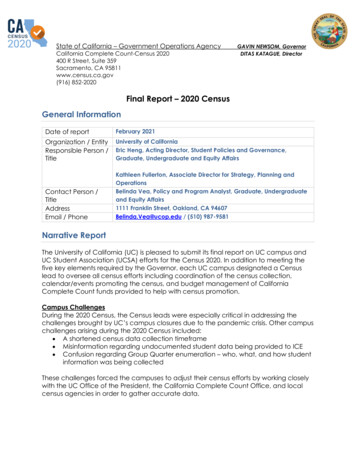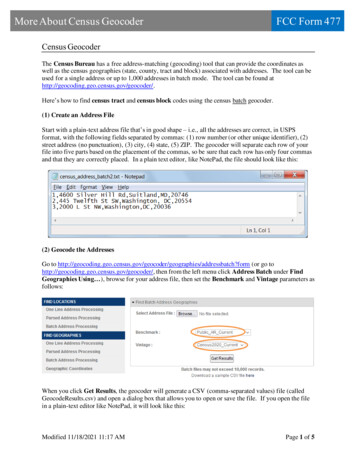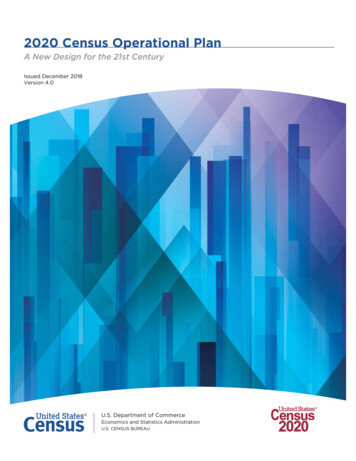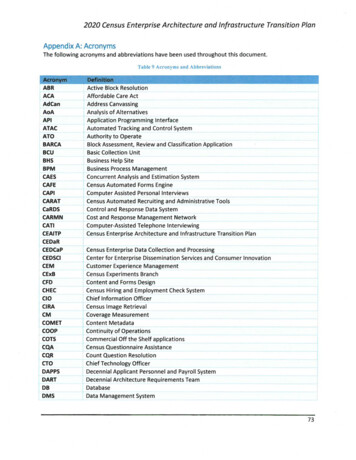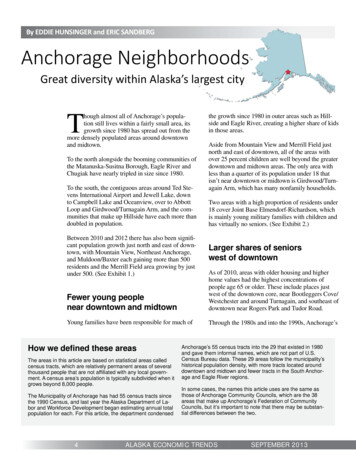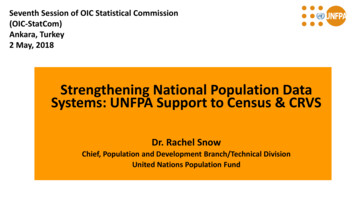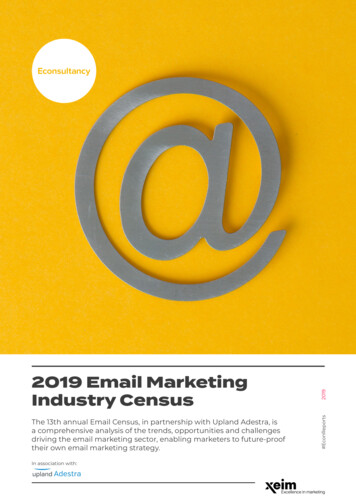
Transcription
The 13th annual Email Census, in partnership with Upland Adestra, isa comprehensive analysis of the trends, opportunities and challengesdriving the email marketing sector, enabling marketers to future-prooftheir own email marketing strategy.In association with:2019#EconReports2019 Email MarketingIndustry Census
2019 EmailMarketing IndustryCensusIn association with Upland AdestraPublished September 2019No part of this publication may be reproduced ortransmitted in any form or by any means, electronicor mechanical, including photocopy, recording or anyinformation storage and retrieval system, without priorpermission in writing from the publisher.Copyright Econsultancy.com Ltd 2019Econsultancy London4th Floor, Wells Point79 Wells StreetLondon, W1T 3QNUnited KingdomTel: 44 207 269 1450Econsultancy New York205 Hudson Street,7th Floor New York,New York, 10013United StatesTel: 1 212 971 0630Email: help@econsultancy.comEconsultancy Singapore10 Anson RoadInternational Plaza #36-01Singapore, 079903Tel: 65 6909 9150Website: http://econsultancy.com
Contents1.Executive Summary42.Foreword by Upland Adestra62.1About Upland Adestra72.1.173.4.5.6.7.8.About Upland SoftwareMethodology83.1Acknowledgements83.2About Econsultancy8Approach to Email94.1Most important attributes of an email technology provider94.2Email marketing practices114.3Measuring success17Email effectiveness and budgets215.1Email campaign performance215.2Ranking of channels for return on investment225.3Proportion of marketing budget spent on email marketing275.4Annual spend on email marketing29Place in the Organisation326.1Responsibility for email marketing326.2Time spent on email activities34Optimising for Different Devices387.1Strategy for optimising email for different devices387.2Tactics used for device optimisation397.3Barriers to optimisation success40Personalisation428.1Ability to provide personalised email campaigns428.2Personalisation challenges448.3What would email marketers like to improve?472019 Email Marketing Industry Census In association with Upland Adestra2
9.10.Marketing Automation509.1Automation triggers509.2Success with automation53Improving Email Marketing for the Future5510.1 Use of predictive and intelligent marketing5510.2 Email innovation5910.3 Email marketing focus6410.4 Use of animated or interactive modules6611.Email marketing success: five tips for better results7012.Appendix7212.1 Respondent profiles7212.2 Additional data762019 Email Marketing Industry Census In association with Upland Adestra3
1.Executive SummaryThe 13th annual Email Marketing Industry Census, published by Econsultancy in partnershipwith Upland Adestra, is based on an online survey of more than 400 marketers carried out inJune and July 2019. The report contains comprehensive analysis of survey data and acomparison with results from previous years, as well as insights from leading email marketingexperts and Econsultancy’s recommendations at the end of the report.The research reveals the following key trends:Email continues to confound expectations around performance and innovation, but emailmarketers still need to justify further investmentEmail continues to lead the pack when it comes to delivery of marketing results, with 73% ofclient-side marketers ranking the channel as excellent, compared to 72% for SEO and 67% forpaid search, in second and third place respectively.Innovation is very much on the agenda for email practitioners seeking to take the channel to newheights, with many companies in planning mode when it comes to new techniques and practices.Disciplines such as marketing automation and personalisation have become established in theemail marketing environment, while marketers are also seeking to harness artificial intelligence(AI) and machine learning to boost the effectiveness of campaigns and deepen customerengagement.But while email continues to evolve and remains the highest-ranked medium for ROI, theresearch shows that the channel still doesn’t receive the level of spend that is justified. Acombination of unsophisticated monitoring, misconceptions about the channel, and other factorsare holding back email from even greater effectiveness.Among the key findings from this year’s Email Census: Many email marketers are focusing on ways to improve message relevance and engagement.A significant proportion of brands are planning to add advanced segmentation (47%), contentpersonalisation (37%) and behavioural targeting (39%) to their email marketing practices. Marketing automation continues to be regarded as the most important capability for improvingemail effectiveness. 66% of respondents highlight automation as an important attribute ofemail solutions, up six percentage points from 60% in 2018. The top three areas for marketers to focus on over the next 12 months are automatedcampaigns (37%), personalisation (32%) and segmentation (29%). On average, email attracted only 13% of company marketing spend in the last year, despitebeing attributed to 19% of sales. Among factors behind this perception gap is that emailmeasurement remains skewed towards non-commercial metrics, such as open and clickthrough rates, and therefore seems short on supporting evidence.Personalisation represents the next wave of innovationPersonalisation is the future of email marketing, as it allows companies to stand out in an alreadyflooded inbox, differentiate themselves from their competitors, and create rich, deeply engagingexperiences with their customers. Despite the progress that has been made, this researchindicates companies could be doing more to provide more targeted and personalised experiencesto achieve higher conversion rates and greater likelihood of purchase.2019 Email Marketing Industry Census In association with Upland Adestra4
Almost a third of marketers (30%) say they have the technological capabilities forpersonalisation, but are in the process of fine-tuning the execution. Data integration is still themost significant obstacle to implementing personalisation, with 51% of marketers reportingthis to be an issue. Antiquated IT systems and legacy software are also holding back companies, as over a thirdof companies (34%) cite a technology shortfall as one of the main challenges to implementingpersonalisation. Over two-thirds of marketers (67%) want to practise better personalisation in 2019, while 62%are focused on garnering cross-channel data.Predictive solutions and AI drive the forward march of data-powered, personalisedmarketingThe growth of artificial intelligence and machine learning presents a huge commercial opportunityfor marketing across the organisation. Looking at email marketing specifically, predictive solutionsallow for the automation of basic processes, based on sophisticated customer analytics, enablingmarketers to make smarter decisions and gain deeper insight into which strategies are the mosteffective. Companies are beginning to deploy AI solutions for email marketing, with 41% of companiesreporting they have fully or partially implemented intelligent solutions for email scheduling,while 27% are using AI for product selection. There has been a significant increase in the use of predictive analytics solutions since 2018when only 34% had fully or partially implemented AI for email scheduling, compared to 41%in 2019.2019 Email Marketing Industry Census In association with Upland Adestra5
2.Foreword by UplandAdestraThe email channel’s longevity, and frankly, sparkling success, can be explained by marketersbeing creative and having fun with email – which is encouraging for such a mature market. Emailallows so much innovation that it never stands still and just keeps reinventing itself. It continues todeliver the highest ROI of any channel, further encouraging marketers to experiment with newtactics.There are signs that modern brands are moving beyond the services that a traditional EmailService Provider (ESP) offers, demanding more cohesive services that are proven to deliver longterm results. It’s no longer good enough for suppliers to simply bolt on an automation module,and a third-party AI engine, to keep customers happy. Suppliers, therefore, must be proactiveoffering customers a better digital experience and a broader, integrated set of tools. The rise ofCXM platforms enables marketers to optimise customer interactions and foster customer loyalty –with email playing a central role.This year, customer expectations are sky high and brands must react. Customers expectpersonalisation, even if only at a basic level. After all, if you have gathered their data you shouldbe using it. Simply tailoring emails to individual customers is often a good place to start but takinga strategic view by making the whole customer experience better can only happen with advancedpersonalisation.Make no mistake, there are still major opportunities in the email market. One area where adoptionremains low is marketing automation. Almost half of companies have no triggered response to asubscription or website signup. Furthermore, over two-thirds send no automated basketabandonment message – effectively ignoring potential new customers. Initial automation successwith an ESP can help the marketing team win over senior management and attain buy-in from allparts of the organisation.To fully understand the benefits of optimisation and analytics, marketers need to stay on top oftrends in predictive solutions, AI/machine learning, CX and personalisation. For example,personalisation and marketing performance can be enhanced by using real-time customerfeedback to influence communication choices. Overlaying customer sentiment analysis alongsideother key customer data, across the lifecycle, can create hyper-personalised campaigns,effectively delivering sentiment-driven marketing success.It’s time for marketers to take action, use the valuable data they have at their fingertips, cherrypick the key tech available, move ahead with automation projects, and start on the journey tobuild a better customer experience. Your customers will thank you for it.Tristam JonesStrategic Customer Success ManagerUpland Adestra2019 Email Marketing Industry Census In association with Upland Adestra6
2.1About Upland AdestraUpland Adestra is a feature-rich email marketing platform that helps clients on their journey toFirst-Person Marketing success.As part of the Upland CXM family, Adestra helps to enhance the total customer experience byempowering marketers to easily and effectively manage and segment data and automatecustomer journeys, maximising ROI.Visit www.adestra.com to find out more.2.1.1About Upland SoftwareUpland Software (Nasdaq: UPLD) is a leader in cloud-based enterprise work managementsoftware. Upland provides seven enterprise cloud solution suites that enable more than onemillion users at over 9,000 accounts to win and engage customers, automate businessoperations, manage projects and IT costs, and share knowledge throughout the enterprise. All ofUpland’s solutions are backed by a 100% customer success commitment and the UplandOneplatform, which puts customers at the centre of everything we do.To learn more, visit www.uplandsoftware.com.2019 Email Marketing Industry Census In association with Upland Adestra7
3.MethodologyThe 2019 Email Marketing Industry Census is the 13th annual edition of this report, publishedby Econsultancy in association with Adestra. Many of the questions have been repeated overthis time period, enabling us to compare data and look at trends.There were 435 respondents to our research request, which took the form of an online survey inJune and July 2019. Respondents included both companies or in-house marketers (70%) andsupply-side respondents, including agencies, consultants and vendors (30%).Information about the survey, including the link, was emailed to Econsultancy’s user base andpromoted on social media and other channels. The incentive for taking part was access to acomplimentary copy of this report just before its publication. Detailed breakdowns of therespondent profiles are included in the Appendix.3.1AcknowledgementsEconsultancy would like to thank the following people for their insights included in this report:3.2 Tim Bond, Head of Insight, Data & Marketing Association Andrew Campbell, Martech Director, Customer Experience Division, The Home Agency Riaz Kanani, CEO, Radiate B2B Kath Pay, CEO & Founder, Holistic Email Marketing Jordie van Rijn, Founder, Email Vendor Selection and eMailMonday Natalie Rockall, Email Marketing Consultant, Eleven11 Digital Jenna Tiffany, Founder & Strategy Director, Let’sTalk Strategy Tim Watson, Email Marketing Consultant, ZettasphereAbout EconsultancyEconsultancy’s mission is to help its customers achieve excellence in digital business, marketingand ecommerce through research, training and events.Founded in 1999, Econsultancy has offices in London, New York and Singapore.Econsultancy is used by over 600,000 professionals every month. Subscribers get access toresearch, market data, best practice guides, case studies and elearning – all focused on helpingindividuals and enterprises get better at digital.The subscription is supported by digital transformation services including digital capabilityprogrammes, training courses, skills assessments and audits. We train and develop thousands ofprofessionals each year as well as running events and networking that bring the Econsultancycommunity together around the world.Subscribe to Econsultancy today to accelerate your journey to digital excellence.Contact hello@econsultancy.com to find out more.2019 Email Marketing Industry Census In association with Upland Adestra8
4.Approach to Email4.1Most important attributes of an email technologyproviderAs a relatively ‘old-school’ digital communications channel, you might be forgiven for thinkingemail marketing has run its course, and that best practices are now fully baked into howbusinesses approach their email activities. Recent consolidation in the market has seen somevendors exit the email technology business, raising questions over how much scope remains forinnovation and value growth in the space.This year’s Email Marketing Industry Census shows the opposite, reiterating that email is very farfrom being a stale medium. It is clear that marketers continue to see a wealth of opportunity toevolve and optimise how they approach email campaigns and have a wide range of requirementswhen it comes to selecting the best solutions to support these plans.Company respondentsFigure 1: What are the most important attributes of an email technology provider?60%66%Marketing automation capability46%User-friendly interface37%Ability to integrate with other best-of-breedmarketing technology30%34%27%31%Cross-channel marketing capabilities33%30%Data / consent compliance26%25%Design tools / support30%Cost21%13%15%Real-time technical supportAccount managementPart of a larger marketing software suite orcloud10%10%8%7%Tech roadmapOther20184%2%2%2%2019Respondents 2018: 427Respondents 2019: 283Notes: Respondents could select up to three options.2019 Email Marketing Industry Census In association with Upland Adestra9
Voice of the expert“It’s unsurprising to see that automation is the most essential attribute of an email technology provider,given consumers’ demands for relevant messaging. For email marketers to be able to achievepersonalisation and relevancy at scale successfully, automation is vital and is an important tool in theemail marketer’s armoury.”Jenna Tiffany, Founder & Strategy Director, Let’sTalk Strategy“It’s interesting to see so many marketers pushing for automation capabilities . While automationclearly offers an opportunity, there’s equally a lot that organisations can do with their existingtechnologies to better target customers with more engaging and targeted content.”Tim Bond, Head of Insight, Data & Marketing Association“Efficiency is clearly top of mind, but marketers are clearly looking for best-of-breed solutions thatintegrate well together and are not restricting themselves to single providers that can over time providean all-in-one solution.”Riaz Kanani, CEO, Radiate B2B“I am glad to see marketing automation, integration and cross-channel marketing being among the topattributes. It is a sign that marketers aspire to bring their triple A-game. Triple-A meaning automated, allchannel and an amazingly adaptive amped-up customer experience. The road to get there meanscombining skills with technology to create a sophisticated and tied-in marketing machine. With currentmartech sophistication, flexibility will become a main differentiator. When brands can set up campaignsfaster, they will be able to shift focus from being ‘able to do it’ to being ‘able to do it better’. As a result,marketers’ experimentation and optimisation abilities are the new hallmarks of a future-proof technologystack.”Jordie van Rijn, Founder, Email Vendor Selection and eMailMondayExpansion plans: Automation, not cost, is a focusMany respondents to this year’s Email Marketing Industry Census have ambitions to improveemail ROI further, and are clearly transmitting this to technology suppliers. Marketing automationcapability, for example, continues to be emphasised as a key software attribute by a majority ofemail practitioners (Figure 1). The proportion of respondents highlighting it as an important areaof focus has risen significantly over the past year (66%, up six percentage points).For email marketing, automation is seen as an opportunity to transform the ‘engine room’ behindcampaigns, and turbo-charge efficiency and effectiveness. It is not just about generating savingsfrom campaigns or playing off scale advantages to increase the scope of existing activities.Strategically, marketers have positioned automation as a way to better leverage data andimprove personalisation, thus engaging with customers more effectively, and creating feedbackloops to drive further gains in ROI.2019 Email Marketing Industry Census In association with Upland Adestra10
Another notable indicator of user enthusiasm for email marketing opportunities is that a lowerproportion of respondents name cost as an important aspect of technology than last year (21%,down from 30%). Natalie Rockall, Email Marketing Consultant at Eleven11 Digital, sees this as apositive signal of marketer intent. “Does this indicate email budgets are on the up and cost is ofless concern? Or are more organisations looking for improved functionality in the systems theyuse to help them deliver even stronger ROI for the email channel? I hope it’s both,” she says.Similarly, Jordie van Rijn, Founder of Email Vendor Selection and eMailMonday, suggests thereduced focus on cost shows increased confidence in the business case for investment in emailtechnology. “If we polled and instead asked [about] ‘value for money’, all marketers would agreethat it is one of the most important attributes. Apparently the value part is already secured, triedand trusted, so the out-of-pocket costs seem less of a thing,” he surmises.Technology shifts: Time to scrutinise suppliersEmail continues to be seen as a distinct field of communication with its own specific technologyrequirements, despite modern-day marketing’s focus on integration and consolidation. But manyrespondents accentuate the importance of email platforms having the ability to integrate withother best-of-breed marketing technology (34%) and support cross-channel marketing (31%).They recognise that email marketing is by no means an ‘island’, and must work in conjunctionwith other channels and systems to produce the best results.However, only a small section of respondents appear to buy into the vision of email softwarebeing subsumed into broader marketing platforms. Only 7% see email functionality being part of alarger marketing software suite or cloud as important.Tim Watson, Email Marketing Consultant at Zettasphere, sees this as significant for the broaderdirection of marketing technology, with some companies starting to question the service andinnovation levels provided by ‘all-in-one’ marketing products. “The email solution marketplace isnothing if not dynamic,” he says. “We continue to see mergers, acquisitions and evendisinvestment in email platforms – notably, IBM selling off the Silverpop platform1 it purchasedfive years ago and Yes Marketing obsoleting its email technology, Yesmail2.”With vendor strategies in flux, it seems worrying that very few email marketers appear to delvedeeply into their solution providers’ technology roadmap. Only 2% view this as an importantsolution attribute, down from 4% in 2018. Watson sees it as particularly important for clients topress technology partners on their willingness to invest in platform development, going forward.“When shopping for technology, ask ‘what key innovations have you introduced in the last12 months?’,” he recommends.4.2Email marketing practicesThat email marketers are not standing still is further reflected in Figure 2. The chart shows thedifferent practices they currently employ, and plan to employ in the future.Most practices are only in use by a minority of companies, but none are merely being left on theshelf – all are being ‘planned’ by a sizeable section of companies surveyed. There are only twocases – dynamic email content and dynamic social feeds – where at least half of users areneither employing them nor planning mail-era/2019 Email Marketing Industry Census In association with Upland Adestra11
Voice of the expert“Dynamic content and social feeds are underutilised in the email space, despite the fact that theynot only save time when creating email content but also provide email campaigns which arerelevant at the time of opening, not at the time of sending. I’ve worked with several brands thathave achieved outstanding results by utilising this technology while also improving the customer’sexperience. This is definitely an area that brings the excitement back into email and is anopportunity for more email marketers to embrace.”Jenna Tiffany, Founder & Strategy Director, Let’s Talk StrategyCompany respondentsFigure 2: Which of the following practices are part of your email marketingefforts?Respondents: 2292019 Email Marketing Industry Census In association with Upland Adestra12
Voice of the expert“Lead scoring can be such a useful feature for email marketers, especially for those in the B2Bspace with sales teams who want quality leads. The position of lead scoring near the bottom of thelist here suggests either brands are not seeing the true value of this practice or the investment inthe setup required puts them off. I’d recommend brands go through an effort versus benefitexercise on this point – the results may surprise.”Natalie Rockall, Email Consultant, Eleven11 DigitalDriving quality and performanceGiven the increased emphasis placed on marketing automation by email marketers, discussed inSection 4.1, it is clear that many survey respondents are focusing heavily on extracting more ROIout of this already highly profitable channel. Many see that a more strategic and integratedapproach to how they harness data will allow them to engage with customers more intelligently,and drive sales.This is further reflected in Figure 2, which signals that many marketers are working on improvingpersonalisation, segmentation and behavioural targeting capability.As in previous years, most marketers (82%) indicate they are performing basic segmentation(using obvious characteristics such as gender or geography), suggesting it is now a largelystandard practice. Only a minority (35%) have progressed beyond this to advancedsegmentation, however. This practice divides recipients into categories based on more in-depthfactors, such as browsing behaviour, past email response or custom variables based on statisticalmodelling.The responses suggest this is set to change in the coming years. The proportion of respondentsperforming advanced segmentation has risen by 4% since 2018 (Figure 3). It is also the capabilitythe largest slice of marketers say they are ‘planning’ to bring into practice (47%). A similarproportion said the same thing in 2018, showing this is a challenging capability to develop, butthis year’s data shows an ongoing commitment and belief that the rewards will be worth it, interms of engagement and ROI.There is a similar story with content personalisation and behavioural targeting, with manymarketers actively seeking to add these capabilities to the mix (37% and 39%, respectively).Zettasphere’s Watson is encouraged by the focus on these areas, noting they are “all great waysto improve relevance” and will lead to more in-depth and long-term customer relationships.“Providing value in previous emails is key to customers continuing to engage,” he notes. “Weoften think in terms of campaign send. But recipients don’t see emails like that. They experienceemail as a continuous stream of communication. What they do is influenced by their experienceof the past – not just how good the current campaign is.”Andrew Campbell, Martech Director of the Customer Experience Division at The Home Agency,sees similar positives, saying that bundling personalisation, segmentation and targeting togetherwill provide “a step change in email performance and unlock synergies across the three individualinitiatives”.2019 Email Marketing Industry Census In association with Upland Adestra13
Voice of the expert“From my own experience at my email agency Let’sTalk Strategy, segmentation is critical for all ofour clients and heavily depended upon. However, we have also advised clients not to overlysegment and re-evaluate the levels and types of segmentation used. Segmentation is beneficialwhen aligned with business and marketing goals and objectives. But there is a delicate balance toachieve when using segmentation. Creating hundreds of niche segments wouldn’t be useful formany organisations: it could impact the effectiveness of email marketing as a channel, making itincredibly difficult to monitor and measure. With segmentation, less is more”Jenna Tiffany, Founder & Strategy Director, Let’sTalk Strategy“Companies have the ambition to move from basic to advanced segmentation. But you don’t haveto segment your whole database and email list completely. Instead go for ‘super segments’ – highlyinteresting and identifiable groups that have big potential. Focus on them, create content for them,identify more look-alikes and attract them to sign up to your email programme. And then? Identifyconversion events (behaviours that signal upcoming shopper intent) and cater for them with timelyoffers. Advanced segmentation is more refined, not more complex, because there is a plan behindits right person-right time approach.”Jordie van Rijn, Founder Email Vendor Selection and eMailMondayMobile remains keyWith email marketers focusing on user behaviour and needs, it is striking that optimising email formobile devices is not more prevalent. It is, naturally, a practice employed by many marketers(72%, behind only basic segmentation), but with only a 2% increase since 2018, a significantproportion of businesses are still missing out on its benefits.2019 Email Marketing Industry Census In association with Upland Adestra14
Company respondentsFigure 3: Proportion of respondents saying these practices are part of their emailmarketing efforts83%84%Basic segmentation71%69%Optimising email for mobile devicesUse of transactional emails for marketingRe-marketingRegular list cleansingEncouraging sharing of content on socialnetworksContent personalisation (beyond just name)Promoting customer ratings and reviewsLead nurturingLead scoringMultichannel triggers (e.g. sales call)Behavioural targeting (based on web activity)Lifecycle programmesAdvanced segmentationUse of video contentLocation-based email contentDynamic email content (live listings /availability)Dynamic social 7%23%2019Respondents 2018: 324Respondents 2019: 229Voice of the expert“It’s great to see that list cleansing has increased in usage dramatically from last year. It’s soimportant for good deliverability and, as there are a wealth of excellent tools out there to use, it’s awise investment. Another one I’m chuffed to see has increased is content personalisation. Themore personal we can make our emails, the more value the subscriber will see in them.”Kath Pay, CEO & Founder, Holistic Email Marketing2019 Email Marketing Industry Census In association with Upland Adestra15
This might be down to a perception that use of mobile-friendly templates provided by the ESP issufficient, but being fully mobile-oriented extends beyond this into assimilating new user habitsand preferences in terms of content consumption and purchasing of goods and services.Understanding these habits and preferences is becoming ever more important.Nearly four in five (79%) UK adults now use a smartphone and more than half (54%) own tablets,according to media and telecoms regulator Ofcom3.Figure 4 and Figure 5 show the supply-side perspective in terms of practices currently beingemployed by their clients. The picture is very much consistent with the client-side data, with basicsegmentation and optimisation for mobile devices being the most widely used tactics.Use of transactional emails for marketing has seen the biggest year-on-year jump, up from 43%in 2018 to 60% in 2019 (Figure 5). These messages are increasingly being utilised by companiesto help meet commercial objectives, whether relating to building loyal
9. Marketing Automation 50 9.1 Automation triggers 50 9.2 Success with automation 53 10. Improving Email Marketing for the Future 55 10.1 Use of predictive and intelligent marketing 55 10.2 Email innovation 59 10.3 Email marketing focus 64 10.4 Use of animated or interactive modules 66 11. Email marketing success: five tips for better results .

